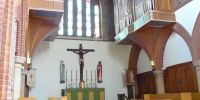
St George’s Church was built in 1901 in Rumboldswyke (now Whyke) as a successor to the Norman church of St Mary’s, originally built in the 11th century.
Following the introduction of the railway, which had been built through the parish in 1846, Thomas Peel Brandram, rector of Rumboldswyke, had plans drawn up for a new church to accommodate the rapidly growing parish. By 1902, under the direction of a new Rector, Charles Farthing, St George’s Church had been built and paid for, mainly with small donations from local people.
Initially it was very basic having no porches, no choir vestry, and only the tiny organ from St Mary’s. However, in 1904, following the death of Charles Farthing, Dr Ernest A Glover was appointed and became responsible for the completion of the church with the addition of the vestry in 1909, and later the porches. He also established the Catholic tradition of worship in St George’s, using St Mary’s for services just four times a year and for funerals.
The old organ of St Mary’s, built by W J Haywood of London, had been transferred to St George’s in 1901 and remained in service there until 1947 when it was replaced by an organ from a church in Lyme Regis. In 1960 the organ was overhauled and stops from a redundant organ in Pagham were added. Subsequent rebuilds in 1962 (Reeves & Merner) and 1987 (Browne) followed.
In 2010, Nicholson & Co. was asked to submit a design for the replacement of the organ and it was proposed that the new organ should be built at the east end of the chancel, either side of the east window. This was felt to be the ideal placing for both looks and tonality and would free up much needed space on the vestry side of the church.
The organ was completed by Easter 2013.





